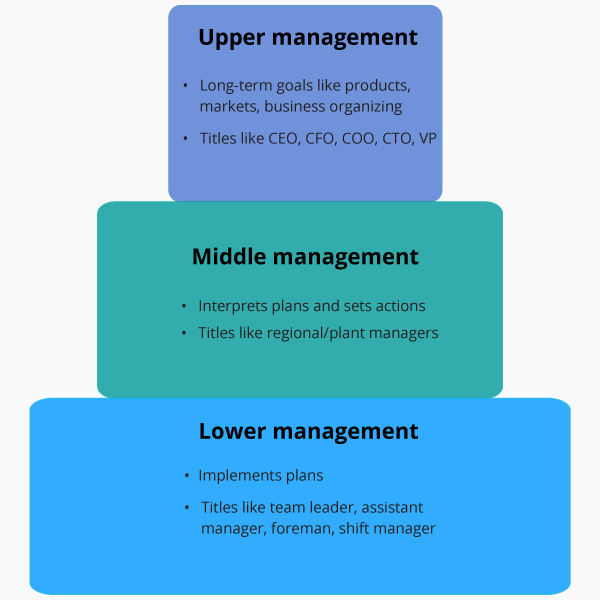Learning Outcome
- Differentiate between leadership, informational, and decision-making roles.
Management Roles

Roles and functions of managers in a top-down organizational structure
We have discussed the types (levels) of managers and some of their responsibilities but not their specific activities. All managers must be comfortable with three main types of activities or roles. To do their jobs, managers assume these different roles. No manager stays in any one role all of the time, but shifts back and forth. These roles are leadership (or interpersonal), informational, and decision making. They were written about in detail in the 1970s by Henry Mintzberg, a professor at McGill University in Canada. His classifications are still one of the most studied descriptors of management roles today.[1]
Leadership and Interpersonal Roles
Which type of manager spends more time in leadership activities? The short answer is all effective managers display leadership characteristics. Leadership is the ability to communicate a vision and inspire people to embrace that vision.
Top managers are often required to fulfill what Mintzberg described as figurehead activities. They are the public face of the management team and represent the business in legal, economic, and social forums.[2] Middle managers are also leaders, although their focus may be more on interpersonal skills, such as motivating employees, negotiating salaries, and encouraging innovation and creativity. First-line managers lead both by example when they actively participate in the tasks assigned to their workers and by modeling the policies and work ethics of the organization.
Informational Roles
Informational roles involve the receiving and sending of information—whether as a spokesperson, a mentor, a trainer, or an administrator. A top manager is a voice of the organization and has to be aware that even personal opinions will reflect (for better or worse) on the business. With the free flow of information on the Internet, it is very difficult for top managers to separate their personal identities from their corporate positions. For example, there was a consumer backlash in 2017 when Uber CEO Travis Kalanick accepted a seat on President Trump’s economic advisory council. Kalanick initially said that he was “going to use [his] position on the council to stand up for what’s right.” He resigned a few days later in response to the protest.[3]
Middle managers must skillfully determine what information from top management should be shared with others, how it should be interpreted, and how it should be presented. Similarly, they must weigh the value of information they receive from first-line managers and employees in order to decide what to forward to top management. If transmitted information tends to be untrue or trivial, then the manager will be viewed as a nonreliable source and his or her opinions discounted.
The informational role for first-line managers is primarily one of disseminating what they have been given and helping the employees to see how their own contributions further organizational goals. They have a responsibility to see that the employees understand what they need to be successful in their jobs.
Decision Making Roles
All managers are required to make decisions, but managers at different levels make different kinds of decisions. According to Mintzberg, there are four primary types of management decision roles. These include the following:
- Entrepreneur. The entrepreneurs in a firm are usually top-level managers. They identify economic opportunities, lead the initiative for change, and make product decisions.
- Disturbance handler. Top and middle managers will react to disturbances (unexpected events) in the organization—whether internal or external. They will decide what corrective actions should be taken to resolve the problems.
- Resource allocator. All levels of management will make resource allocation decisions, depending upon whether the decision affects the entire organization, a single department, or a particular task or activity.
- Negotiator. Depending on the effect on the organization, most negotiation is done by top and middle-level managers. Top managers will handle negotiations that affect the entire organization, such as union contracts or trade agreements. Middle-level managers negotiate most salary and hiring decisions.[4]
To summarize, managers must play many roles. Some are better than others in particular roles and will tend to be called on for those jobs. Putting a diverse management team in place will ensure that the organization has enough managers to meet most challenges.
Candela Citations
- Management Roles. Authored by: John and Lynn Bruton. Published by Lumen Learning. License: CC BY: Attribution
- Image: Roles and functions of managers in a top-down organizational structure. Authored by: JMcIntyre. Located at: http://jmcintyre.wikispaces.com/bbi2o_functions_of_business_management. License: CC BY-SA: Attribution-ShareAlike
- B. (2016, September 20). Mintzberg's Management Roles - Boundless Open Textbook. Retrieved July 28, 2017, from https://www.boundless.com/management/textbooks/boundless-management-textbook/introduction-to-management-1/additional-roles-and-skills-of-managers-20/mintzberg-s-management-roles-127-605/ ↵
- Ibid. ↵
- Pittsburghers Protest Uber As CEO Reacts To Public Outcry. (n.d.). Retrieved July 28, 2017, from http://pittsburgh.cbslocal.com/2017/02/04/pittsburgh-uber-protest/ ↵
- Mintzberg's Management Roles - Boundless Open Textbook. ↵
